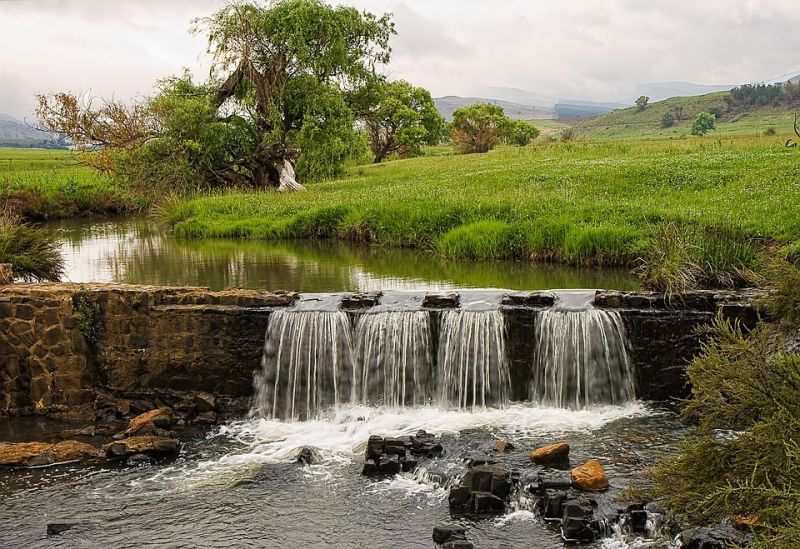Jointed Stormwater Management and Stream Restoration Reduce Erosion and Pollution in Colorado
Published on by Water Network Research, Official research team of The Water Network in Case Studies
Both stormwater control and stream restoration are proven ways to reduce erosion along water channels. Often, though, each method is managed by a different urban land-management department, measuring different success values. Efforts are rarely coordinated due to funding and other constraints.
By Susan V. Fisk, American Society of Agronomy

Representative image of a strem: Pixabay, labeled for reuse
Rod Lammers and his colleagues at the University of Georgia looked at some computerized models to see if coordinating these land management practices with common goals might have a greater positive impact on erosion. The good news? It does.
First, let’s take a look at why stormwater management systems are necessary. In nature, precipitation falls onto forests, prairies and other soil-based areas. The water is soaked into the soil, down into the water table, and out into water bodies. Eventually, through evaporation, that water gets back into the atmosphere – until the next precipitation event.
In cities, though, pavement, rooftops, and other structures break the water cycle. City managers and engineers develop stormwater management systems to collect and move water in long tunnels, under buildings, and out to waterways. The more impermeable structures and the larger the area, the more complex the system must be.
No matter the system, the water must go somewhere. After all, we don’t want it in our basement or parking garage.
Because this stormwater hasn’t been able to take advantage of soils’ natural ability to clean water, the water can be filled with sediment, and undesirable nutrients. These can take a toll on the stream habitats and harm sensitive ecosystems downstream. In addition, the larger runoff volumes and higher and more frequent peak flows can lead to stream bank erosion. The UGA study only looked at sediments and nutrients coming from the soil eroded in the channels.
Lammers and his team looked at newer stormwater management approaches, called green infrastructure. These types of structures attempt to allow more water to soak into the soil like a natural system. “We are essentially trying to ‘restore’ the city to a more natural water cycle,” says Lammers.
Each combination of stormwater controls and restoration projects results in its own improvements. However, “piecemeal approaches to stormwater management and stream restoration miss synergistic benefits,” says Lammers. “They make restoration projects more prone to failure, wasting valuable resources for pollutant reduction.”
Stormwater management programs often focus on peak flow rates of large, less frequent storms. They also attempt to removed suspended solids, as well and nitrogen and phosphorus.

Rain gardens are an effective “green infrastructure” measure to allow water to soak into the ground, instead of going down into the stormwater drain. Credit: Rod Lammers, America Society of Agronomy
Lammers’ team developed computerized models to predict the effects of three different stream restoration scenarios and three different stormwater treatment scenarios . Thus, there were scenarios with a combination of restoration and treatment techniques. Such an “experiment” in the field would take a long time and involve a lot of expense.
“Computer modeling is a powerful tool. We can test the relative success of different management approaches, over years or even decades,” says Lammers. “These results can then be used by agencies to help with their planning. Of course, modeling has its limitations. Monitoring the actual performance of stormwater practices and stream restoration is essential. They also have to adapt management approaches based on observed successes and failures.”
“Our results suggest that watershed-scale implementation of stormwater controls that reduce runoff volume is essential,” says Lammers. “The controls need to address a spectrum of storm sizes. This is a more effective approach for reducing channel erosion than stream restoration. Aggressive, early implementation may have resulted in even less pollution by avoiding erosion early on. Much like investing early in life leads to greater financial returns, early implementation of stormwater controls and restoration can result in greater water quality and channel stability benefits.”
“Stream restoration can complement effective stormwater treatment to reduce erosion and pollutant loading,” says Lammers. “However, these approaches should be coordinated to achieve the best results. In addition, stormwater controls have a much greater potential to reduce stream erosion than channel restoration. Cities need to address the root cause of erosion – the altered urban water cycle. That is more effective than only treating the symptoms by stabilizing the channel itself.”
Since this study was done in Colorado, future research could be done to apply similar approaches in different climates. Different rainfall patterns might result in different effectiveness of stormwater controls. Also, looking at different restoration strategies, like floodplain reconnection to reduce the velocity and erosive power of floods, would be interesting. Similarly, it would be useful to compare different stormwater control strategies, to see which perform best in different scenarios.
Reference :
Lammers, R. W., T. A. Dell, and B. P. Bledsoe. 2019. Integrating Stormwater Management and Stream Restoration Strategies for Greater Water Quality Benefits. J. Environ. Qual. 0. doi:10.2134/jeq2019.02.0084
Source : American Society of Agronomy
Media
Taxonomy
- Stormwater Management
- Stormwater
- Storm Water Management
- green infrastructure
- Stream Restoration